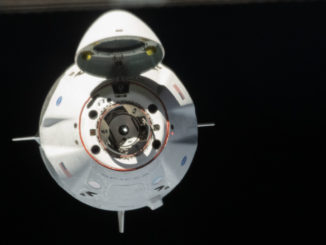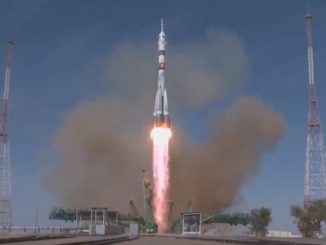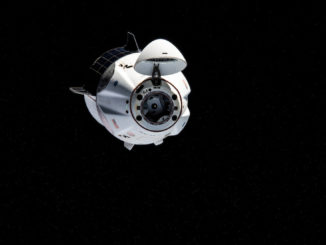
While one of its two science instruments remains sidelined, NASA’s InSight probe has proven Mars is seismically active through the detection of hundreds of quakes, some of which can be traced to a volcanic region nearly 1,000 miles away.
Since landing on Mars in November 2018, the InSight spacecraft’s French-built seismometer has detected more than 450 seismic signals to date, according to NASA. Scientists believe the “vast majority” of the signals are probably from quakes, but some could be generated by wind.
But none of the quakes registered by InSight have been stronger than magnitude 4.0, too weak to penetrate Mars’ mantle and core and reveal insights about the red planet’s deep interior.
Data from the first year of results from NASA’s InSight mission were published in six papers Monday. Scientists released the papers in in the scientific journals Nature and Nature Geoscience.
InSight is the first mission to detect a “marsquake” on the red planet. The spacecraft landed on a broad equatorial plain in a region known as Elysium Planitia.
“The detections thus far are consistent with tectonic origins, with no impact-induced seismicity yet observed, and indicate a seismically active planet,” the InSight science team wrote in Nature.
The first batch of seismic measurements suggest Mars is “moderately active” with far more quakes than detected on the moon, scientists wrote in Nature. Mars lacks the tectonic plates responsible for the strongest seismic tremors on Earth, but evidence of volcanic activity on Mars in the recent geologic past could provide clues to one origin of the quakes registered by InSight.
“Mars trembles more often – but also more mildly – than expected,” NASA said.
Scientists traced the origin of two of the quakes to a region named Cerberus Fossae roughly 1,000 miles (1,600 kilometers) to the east of the InSight landing site. Images acquired by cameras orbiting Mars show faults and channels in the Cerberus Fossae region, evidence of lava flows and running water. Some of the volcanic flows at Cerberus Fossae occurred in the last 10 million years, scientists concluded due to the lack of fresh impact craters in the region.
Landslides at Cerberus Fossae appear to indicate boulders may have been shaken loose by marsquakes, presumably tremors triggered by volcanic activity.
“It’s just about the youngest tectonic feature on the planet,” said Matt Golombek, a planetary geologist at JPL. “The fact that we’re seeing evidence of shaking in this region isn’t a surprise, but it’s very cool.”

Scientists believe InSight may landed on Mars during a relatively quiet period of seismic activity because it took several months for the probe to detect its first confirmed seismic signal. By the end of 2019, the mission’s seismic instrument — named SEIS — was detecting around two seismic events per day.
Meanwhile, InSight’s other science instrument — an underground heat probe — continues having trouble hammering into the Martian soil.
The German-built Heat Flow and Physical Properties Package, or HP3, instrument was supposed to burrow up to 16 feet (5 meters) into the Martian crust, deeper than any sensor from previous Mars missions.
The HP3 instrument’s self-hammering mole got stuck on the first day it began digging into the Martian soil. The soil at InSight’s landing site appears to clump together rather than loosely fall around the mole as it hammers.
Inspections using InSight’s robot arm camera indicated the presence of 2 to 4 inches (5 to 10 centimeters) of duricrust, a type of cemented soil thicker than anything encountered on other Mars missions, NASA officials said. The duricrust is also different from the soil the mole was designed for.
The unique soil properties have caused the mole to bounce in place as it recoils from each stroke of its built in hammer mechanism, rather than dig deeper as designed.
Last summer, ground controllers began using the scoop on the InSight lander’s robotic arm to push against the side of the 16-inch-long (40-centimeter) spike as it resumed hammering into the ground. The pinning method appeared to help, but the mole backed out of the ground two times.
Now mission managers have elected to try a more risky method to push on the back cap of the mole with the robotic arm as the spike hammers into the ground.
Ground teams will take it slow with the new pushing method to avoid damaging an umbilical that trails behind the mole. The tether contains multiple temperature sensors to gather thermal data at various depths underneath the Martian surface, and cables to route science data back to the InSight lander for transmission to Earth.

The heat flow measurements intended to be collected by the HP3 instrument are part of the $1 billion InSight mission’s so-called “Level 1” requirements, but were listed as a stretch goal, not as a requirement for minimum mission success, according to Bruce Banerdt, the mission’s principal investigator at JPL.
“NASA funds our mission and supports us, and in return, we sort of promise a certain number of scientific measurements and results,” Banerdt said last year. “We have about 10 of those for InSight. We call them our Level 1 requirements, and one of those Level 1 requirements is for a measurement of the heat flow of Mars using our HP3.
The mission must meet at least six of the 10 Level 1 requirements to meet minimum success criteria, according to NASA officials.
The InSight mission’s third major science investigation is the Rotation and Interior Structure Experiment, or RISE. This experiment uses radio signals traveling between InSight and Earth receiving stations to track the wobble of Mars as it rotates, yielding insights into the planet’s interior structure, including whether Mars has a liquid or solid core.
Scientists have not yet made any conclusions from the RISE investigation.
“A solid core would cause Mars to wobble less than a liquid one would,” NASA said. “This first year of data is just a start. Watching over a full Martian year (two Earth years) will give scientists a much better idea of the size and speed of the planet’s wobble.”
Other data collected by InSight last year suggest rocks beneath the probe’s landing site are more magnetized than scientists predicted. The magnetic signals are relics left over from when Mars had a magnetic field billions of years ago.
The Martian magnetic field withered away, but rocks buried 200 feet (61 meters) to several miles beneath the planet’s surface were magnetized by the field. Rocks closer to the surface are too young to carry the remnant magnetism.
InSight carried the first magnetometer to the surface of Mars to investigate how the magnetic field’s ancient impacts can still be sensed today. The initial InSight results indicate the magnetism coming from the deep rock layers is 10 times stronger than expected.
“This magnetism must be coming from ancient rocks underground,” said Catherine Johnson, a planetary scientist at the University of British Columbia and the Planetary Science Institute. “We’re combining these data with what we know from seismology and geology to understand the magnetized layers below InSight. How strong or deep would they have to be for us to detect this field?”
Weather sensors on InSight have detected thousands of whirlwinds passing over the lander in its first year on Mars. The mission’s flat landing site has more whirlwinds than other place on Mars with weather instruments, but InSight’s cameras have not spotted any dust devils, which occur when the spinning winds pick up grit and become visible, according to NASA.
Email the author.
Follow Stephen Clark on Twitter: @StephenClark1.



